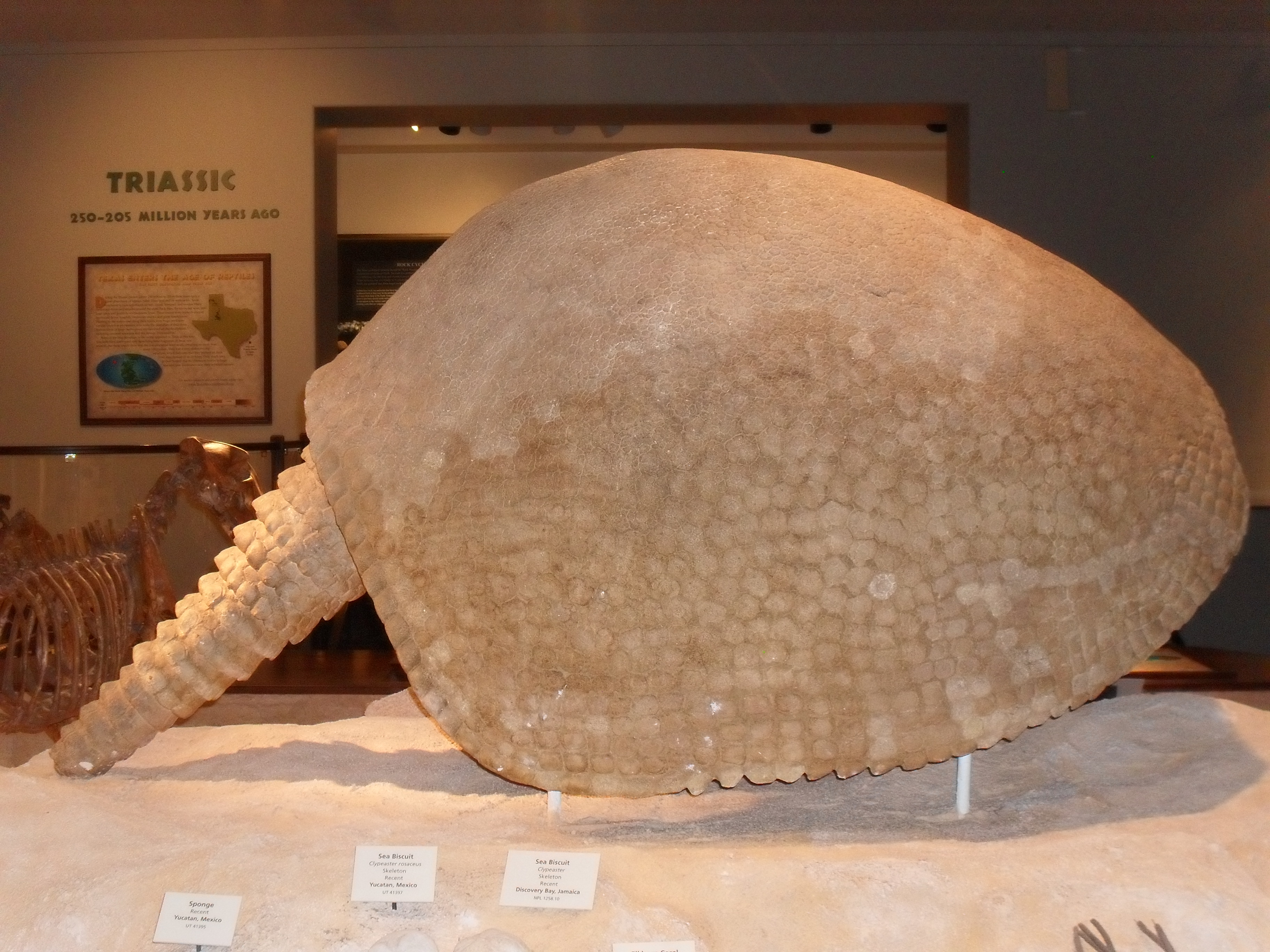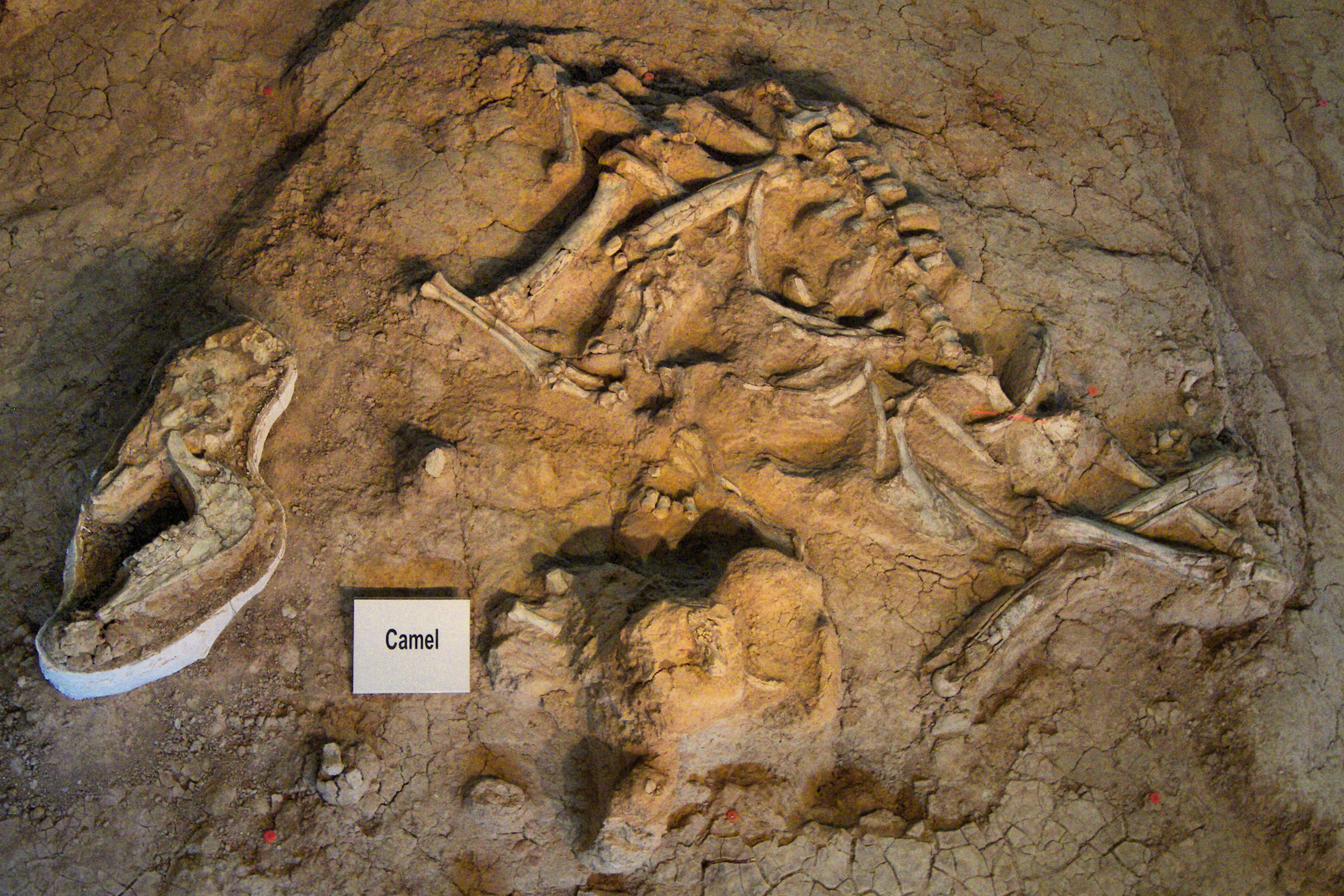|
Mount Blanco
Mount Blanco is a small white hill — an erosional remnant — located on the eastern border of the Llano Estacado within Blanco Canyon in Crosby County, Texas. With Blanco Canyon, it is the type locality of the Blanco Formation of Texas and Kansas, as well as the Blancan fauna, which occurs throughout North America. Geology The term "Blanco Canyon beds", later shortened to "Blanco beds", was first applied to this formation in 1890 by William F. Cummins of the Geological Survey of Texas. The Blanco beds are considered to be of lacustrine origin – deposited in a Pleistocene lake basin set upon the Ogallala Formation of Pliocene age, which underlies the upper surface sediments of the Llano Estacado. The thickness of the Blanco beds varies from around thick. The formation mainly consists of light-gray, fine-grained mudstone, sandstone, and some conglomerate. These light-colored sediments contrast sharply with the locally rust-colored sediments of the Ogallala Formation. Fossi ... [...More Info...] [...Related Items...] OR: [Wikipedia] [Google] [Baidu] |
Butte
__NOTOC__ In geomorphology, a butte () is an isolated hill with steep, often vertical sides and a small, relatively flat top; buttes are smaller landforms than mesas, plateaus, and tablelands. The word ''butte'' comes from a French word meaning knoll (but of any size); its use is prevalent in the Western United States, including the southwest where ''mesa'' ( Spanish for "table") is used for the larger landform. Due to their distinctive shapes, buttes are frequently landmarks in plains and mountainous areas. To differentiate the two landforms, geographers use the rule of thumb that a mesa has a top that is wider than its height, while a butte has a top that is narrower than its height. Formation Buttes form by weathering and erosion when hard caprock overlies a layer of less resistant rock that is eventually worn away. The harder rock on top of the butte resists erosion. The caprock provides protection for the less resistant rock below from wind abrasion which leaves i ... [...More Info...] [...Related Items...] OR: [Wikipedia] [Google] [Baidu] |
Nannippus
''Nannippus'' is an extinct genus of three-toed horse endemic to North America during the Miocene through Pleistoceneabout 13.3—1.8 million years ago (Mya), living around 11.5 million years. This ancient species of three-toed horse grew up to 3.5 feet (1.09 meters) and weighed between 165 pounds to 199 pounds, which was around the same size as a Sheep, domestic sheep. ''Nannippus'' lived as far south as central Mexico (''N. peninsulatus'') to as far north as Canada (''N. lenticularis''), to California in the west, and North Carolina (''N. lenticularis'') and Florida (''N. peninsulatus'') in the east. Unlike its relatives, ''Nannippus'', as well as all other three-toed horses endemic to North America, were browsers and mixed feeders that had diets consisting of C3 plants. Species *''N. aztecus'' Mooser, 1968. Widespread in Florida and also found in Texas, Oklahoma, and Chihuahua, became extinct 11.2—5.7 Mya. *''N. beckensis'' Dalquest and Donovan, 1973 found in Texas only and ... [...More Info...] [...Related Items...] OR: [Wikipedia] [Google] [Baidu] |
Glyptotherium
''Glyptotherium'' (from Greek for 'grooved or carved beast') is a genus of glyptodont (an extinct group of large, herbivorous armadillos) that lived from the Early Pliocene, about 4.9 million years ago, to the Early Holocene, around 7,000 years ago, in the United States, Mexico, Guatemala, Costa Rica, Honduras, El Salvador, Panama, Venezuela, and Brazil. The genus was first described in 1903 by American paleontologist Henry Fairfield Osborn with the type species being, ''G. texanum,'' based on fossils that had been found in the Pliocene Blancan Beds in Llano Estacado, Texas, USA. The genus has since been discovered in many more fossil sites. Another species, ''G. cylindricum'', was named in 1912 by fossil hunter Barnum Brown on the basis of a partial carapace, teeth, and several additional fossils that had been unearthed from the Pleistocene deposits in Jalisco, Mexico. Glyptodonts were typically large, graviportal, herbivorous armadillos with armored carapaces that were ... [...More Info...] [...Related Items...] OR: [Wikipedia] [Google] [Baidu] |
Glyptodontidae
Glyptodonts are an extinct subfamily of large, heavily armoured armadillos. They arose in South America around 48 million years ago and spread to southern North America after the continents became connected several million years ago. The best-known genus within the group is ''Glyptodon''. While they were formerly considered to constitute the distinct family Glyptodontidae, in 2016, an analysis of ''Doedicurus'' Mitochondrial DNA (also known as mtDNA / mDNA) found that it was, in fact, nested within the modern armadillos as the sister group of a clade consisting of Chlamyphorinae and Tolypeutinae. For this reason, glyptodonts and all armadillos but '' Dasypus'' were relocated to a new family, Chlamyphoridae, and glyptodonts were demoted from the former family Glyptodontidae to a subfamily. Evolution Glyptodonts first evolved during the Eocene in South America, which remained their center of species diversity. For example, an Early Miocene glyptodont with many primitive f ... [...More Info...] [...Related Items...] OR: [Wikipedia] [Google] [Baidu] |
Edentata
Xenarthra (; from Ancient Greek ξένος, xénos, "foreign, alien" + ἄρθρον, árthron, "joint") is a major clade of placental mammals native to the Americas. There are 31 living species: the anteaters, tree sloths, and armadillos. Extinct xenarthrans include the glyptodonts, pampatheres and ground sloths. Xenarthrans originated in South America during the late Paleocene about 60 million years ago. They evolved and diversified extensively in South America during the continent's long period of isolation in the early to mid Cenozoic Era. They spread to the Antilles by the early Miocene and, starting about 3 Mya, spread to Central and North America as part of the Great American Interchange. Nearly all of the formerly abundant megafaunal xenarthrans became extinct at the end of the Pleistocene. Xenarthrans share several characteristics not present in other placental mammals, which suggest their ancestors were subterranean diggers for insects. The name Xenarthra de ... [...More Info...] [...Related Items...] OR: [Wikipedia] [Google] [Baidu] |
Platygonus
''Platygonus'' ("flat head" in reference to the straight shape of the forehead) is an extinct genus of herbivorous peccaries of the family Tayassuidae, endemic to North and South America from the Miocene through Pleistocene epochs (10.3 million to 11,000 years ago), existing for about . ''P. compressus'' stood 2.5 feet (0.75 meters) tall. Description Most ''Platygonus'' species were similar in size to modern peccaries especially giant peccary, at around in body length, and had long legs, allowing them to run well. They also had a pig-like snout and long tusks which were probably used to fend off predators. Taxonomy While long thought to be the sister-lineage to the Chacoan peccary based on morphological similarities, a 2017 ancient DNA study which recovered mitochondrial DNA from ''Platygonus'' found that all living peccaries are more closely related to each other than they are to ''Platygonus''. The estimated divergence between ''Platygonus'' and all living peccaries ... [...More Info...] [...Related Items...] OR: [Wikipedia] [Google] [Baidu] |
Odocoileus
''Odocoileus'' is a genus of medium-sized deer (family Cervidae) containing three species native to the Americas The Americas, which are sometimes collectively called America, are a landmass comprising the totality of North America, North and South America. The Americas make up most of the land in Earth's Western Hemisphere and comprise the New World. ....''Odocoileus'' Mammal Species of the World, 3rd Edition [...More Info...] [...Related Items...] OR: [Wikipedia] [Google] [Baidu] |
Cervidae
Deer or true deer are hoofed ruminant mammals forming the family Cervidae. The two main groups of deer are the Cervinae, including the muntjac, the elk (wapiti), the red deer, and the fallow deer; and the Capreolinae, including the reindeer (caribou), white-tailed deer, the roe deer, and the moose. Male deer of all species (except the water deer), as well as female reindeer, grow and shed new antlers each year. In this they differ from permanently horned antelope, which are part of a different family (Bovidae) within the same order of even-toed ungulates (Artiodactyla). The musk deer (Moschidae) of Asia and chevrotains (Tragulidae) of tropical African and Asian forests are separate families that are also in the ruminant clade Ruminantia; they are not especially closely related to Cervidae. Deer appear in art from Paleolithic cave paintings onwards, and they have played a role in mythology, religion, and literature throughout history, as well as in heraldry, such as r ... [...More Info...] [...Related Items...] OR: [Wikipedia] [Google] [Baidu] |
Titanotylopus
''Titanotylopus'' is an extinct genus of terrestrial herbivore in the family Camelidae, endemic to North America from the late Hemphillian stage of the Miocene through the Irvingtonian stage of the Pleistocene. It was one of the last surviving North American camels, after its extinction, only '' Camelops'' remained. Its closest living relative is the Bactrian camel. Its name is derived from the Greek words Τιτάν, τύλος and πούς — "Titan", "knob" and "foot"; thus, "giant knobby-foot." Paleobiology ''Titanotylopus'' is distinguished from other early large camelids by its large upper canines and other distinguishing dental characteristics, and absence of lacrimal vacuities in the skull. Unlike the smaller, contemporaneous '' Camelops'', ''Titanotylopus'' had relatively broad second phalanges, suggesting that it had true padded "cameltoes," like modern camels.Björn Kurtén and Elaine Anderson ''Pleistoceone Mammals of North America'' (New York : Columbia Un ... [...More Info...] [...Related Items...] OR: [Wikipedia] [Google] [Baidu] |
Camelops
''Camelops''Being occasionally called ''Western Camel'' or ''Yesterday's Camel''. is an extinct genus of camels that lived in North and Central America, ranging from Alaska to Guatemala, from the middle Pliocene to the end of the Pleistocene. It is more closely related to the Old World dromedary and bactrian and wild bactrian camels than the New World guanaco, vicuña, alpaca and llama; making it a true camel of the Camelini tribe. Its name is derived from the Ancient Greek (, "camel") and (, "face"), i.e. "camel-face". Taxonomy and evolution The genus ''Camelops'' first appeared during the middle Pliocene (about 4.0–3.2 million years ago (Mya) in southern North America and became extinct at the end of the Pleistocene (around 11,000 years ago). Despite the fact that camels are popularly associated with the deserts of Asia and Africa, the family Camelidae, which comprises camels and llamas, originated in North America during the middle Eocene period, at least 44 Mya. Both ... [...More Info...] [...Related Items...] OR: [Wikipedia] [Google] [Baidu] |
Blancocamelus
''Blancocamelus'' is an extinct genus of Terrestrial animal, terrestrial herbivores the family (biology), family Camelidae, endemic to North America during the Pliocene through Pleistocene—4.9 million years ago until 300,000 years ago, existing for about 4.6 million years. Taxonomy ''Blancocamelus'' was named by Dalquest (1975). Its type species is ''Blancocamelus meadei''. It was assigned to the Camelidae by Dalquest (1975) and Carroll (1988).R. L. Carroll. 1988. ''Vertebrate Paleontology and Evolution''. W. H. Freeman and Company, New York 1-698 References Prehistoric camelids Prehistoric even-toed ungulate genera Pliocene even-toed ungulates Pleistocene even-toed ungulates Extant Pliocene first appearances Pleistocene genus extinctions Prehistoric mammals of North America {{paleo-eventoedungulate-stub ... [...More Info...] [...Related Items...] OR: [Wikipedia] [Google] [Baidu] |



_(cropped).jpg)


.jpg)
